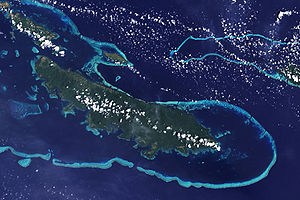Reef
A reef (Old Norse rif "rib; reef") is a more or less elongated elevation that rises from the water bottom towards the water surface. A reef can lie deep below the water surface, reach up to it or even rise above it. The water body is usually a shelf sea.
There are three main forms:
- Rock reefs: consist of solid rock of various origins; if they rise above the water surface, they are also called cliffs.
- Sand reefs: consist of sand washed together (→ sandbank)
- biogenic reefs: consist of sessile marine organisms with calcareous skeletons that grow on top of each other, thus forming massive limestone bodies over time
While rocky and sandy reefs are usually only called this when they form a shallow area or penetrate the surface of the water, the term is also used for biogenic reefs when they lie relatively far below the surface of the water. Here the term "reef" has not only a morphological but also an ecological reference: "reef" as a designation for a habitat or ecosystem. In this sense, elevations that consist of solid rock and do not form a shoal, but are densely populated with invertebrates without a calcareous skeleton, are also called "reefs".
However, these are not biogenic reefs in the true sense, because "biogenic" means that the reef body as such has been built by invertebrates, so-called reef builders. The best known biogenic reefs are coral reefs. They are predominantly built from colonies of stony corals. The Great Barrier Reef off the northeast coast of Australia is probably the most popular example of a coral reef complex. However, smaller reefs can also be formed by other hard-growing animals, such as oyster reefs. In marine regions where reef-building organisms live, reefs can be created by human intervention (→ artificial reef).
In the course of the earth's history, each epoch had its preferred reef builders. Already 2-3 billion years ago, in the Precambrian, the so-called stromatolites were formed by the activity of blue-green algae, which could grow to relatively large, reef-like formations (blue-green algae are still subordinately involved in reef building today, however). In the Silurian and Devonian (ca. 440-360 mya) stromatopore reefs predominated. During the Cretaceous, ca. 100 million years ago, bivalves with a coral-like appearance, the so-called rudists, were important reef builders.
Biogenic reefs are geologically very significant. The rocks that result from biogenic reef formation are called reef limestones. Opened fossil reef complexes are found as mass limestones in almost all mountain ranges, including the Guadalupe Mountains in Texas, the Rhenish Slate Mountains in western Germany and the Dolomites in northern Italy.
Mass limestones lying deep underground are important reservoir rocks for crude oil and natural gas.

Lively rocky reef as submarine continuation of the rocky coast near Messina (Acquarone cliff), Sicily

Satellite image of Vanatinai Island with clearly visible coral reef fringe (light blue).
Search within the encyclopedia